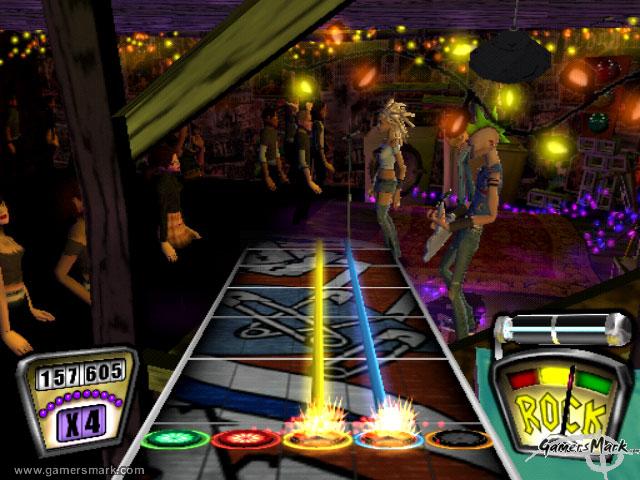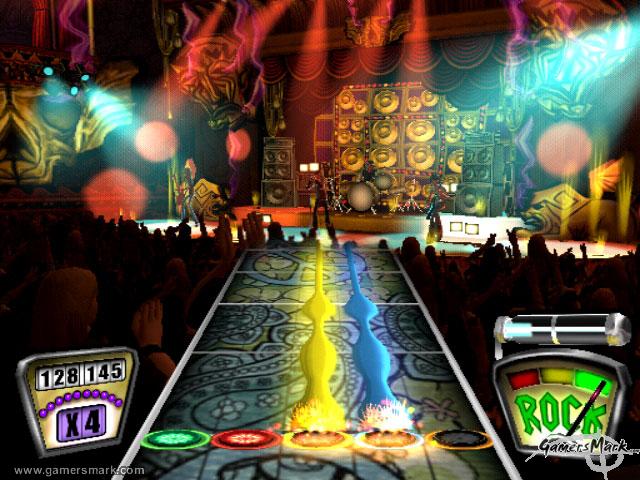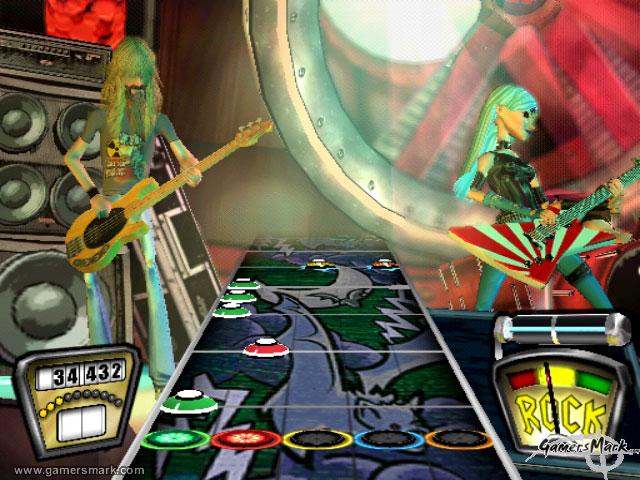Developer: Harmonix Music Studios / Publisher: RedOctane || Overall: 9.5/10
I’ve never been a fan of beat games, half the reason being that I completely suck at them. The other being I really had no interest in playing any — that was, until Guitar Hero. At first, the biggest factor for my interest had been the guitar controller that actually came with the game, since I play the bass guitar; I found the novelty of playing with the guitar controller appealing. When first playing Guitar Hero you don’t have to have any previous experience playing a guitar (though it could help), as the game slowly builds on difficulty as progression is made. There are plenty of awesome songs available to play, each with four difficulty levels. Not only is Guitar Hero fun to play, but it actually feels like you’re playing the song. Guitar Hero can be appealing to a lot of different people, just from my own anecdotal evidence, and gives people the chance to experience how it would be like to play a guitar without actually having a real one.
There’s no story involved with Guitar Hero, you dive right into the Career mode with nothing more than the name of your band and the guitar controller in hand. As you play through the career mode, more songs will unlock, allowing you to play them any time you’d like in the Quick Play mode or during multiplayer. In total, there’s about thirty songs made by famous artists such as Ozzy Osbourne, Jimi Hendrix, and Incubus – all redone by a different band, not the original artists, but it could be hard to tell the difference at times. Once you master all the famous songs, there’s a ton of bonus songs recorded by lesser-known bands.
The guitar controller that comes with the game has numerous features to it. Five “fret” buttons are played by your left hand (if you’re right-handed), a wammy bar, a “strum bar” that is played by your right hand to actually play the notes, as well as start and select buttons that look like volume knobs. There’s a guitar strap that you can put on if you want to play standing up. The guitar is also tilt-sensitive, so when you tilt the guitar while playing the game you can activate something called “Star Power” which will be explained later on. The guitar controller is about half the size of an actual guitar, so it doesn’t take a lot of space while you’re not using it. The box that you buy the game with can actually be used as a guitar case for storing the guitar controller when you’re not using it, if you so desired. The guitar controller can’t really be used to play any other game except for Guitar Hero, since it doesn’t have all the functionality of a Dual Shock 2 – but it doesn’t hurt to experiment.
The basic functions of the game are quite simple. You hold down a fret button and strum the strum bar at the right time to play a note as it appears on screen. When you start the game on easy, it’ll only use three of the fret buttons, adding on a fret button for each difficulty level higher. As you increase difficulty level, more advanced techniques must be used, like holding notes, hammer-ons, and pull-offs — just like on a regular guitar. As you increase difficulty level, more notes are tossed into songs you’ve already become familiar with, making it feel like you’re playing the song a little bit more realistically, as well as making it seem like the song you played before is completely different from what you’re playing once you increase difficulty. This gives you incentive to go back and play the easier difficulties in the game to get perfect scores during Free Play, just to see how high you can get.
When you hold notes, you can use the whammy bar on the guitar controller to make the note distorted, and make the song sound a little bit different each time you play it. Using the whammy bar at certain times will also help increase your “Star Power” that, when activated, will give you twice as many points for each note you play while it lasts. The more notes you play without any error, the higher the multiplier is, as well. Without using Star Power, you can get up to a “X4” multiplier, and with Star Power a “X8” multiplier. Using Star Power at the right time will result in higher scores, especially when you use Star Power when there are a lot of notes to be played. Another way Star Power can help is when your Rock Meter is low. The Rock Meter is basically the approval rating the audience is giving you, which equates to how many notes you get right. If you miss a lot, your Rock Meter is going to be in the red. Conversely, if you get all the notes right, you’ll be in the green. Star Power helps you get back up toward the green by giving you a higher boost than normal for each note you get correct.
When it comes to aspects other than the guitar and actually playing, Guitar Hero suffers just a bit. The graphics are what you’d expect from a late-generation PlayStation 2 game, but there are better looking and more interesting games that have come along recently. The sound, quite obviously, is spectacular. Since all of the songs are not by their original artists, but redone for the game, it’s amazing how alike they can sound to the original songs. Another really cool thing about the sound is that when you miss a note, the song actually misses a note, so you hear what you actually play (or don’t play). There are a lot of songs to keep anyone busy with, and how the songs have been designed really helps with immersion. A multiplayer mode is included as well, so that when your friend brings over their Guitar Hero controller, you can “duel” by trying to play songs better than each other. Multiplayer games can be come pretty heated with one note being the difference between loss and win. Multiplayer mode really required a stereo TV/sound system, since one speaker will be one player and the other speaker will be the other.
Guitar Hero is one of the most fun games I have personally played on any console to date. I’ve played it so much that my left hand felt like it was sprained for a month because I couldn’t stop playing it for so long. Not only that, it takes a lot of skill and practice to beat every song on expert, so the game doesn’t get old as fast as other beat games might. The only drawback I felt the game had was the limited amount of songs it had, while there was a good selection to begin with, it would have been nice to be able to download more songs to play. Guitar Hero is also a bit more expensive than a regular game due to the guitar controller being included, but in the end it’s worth every penny you spend on it and more.



